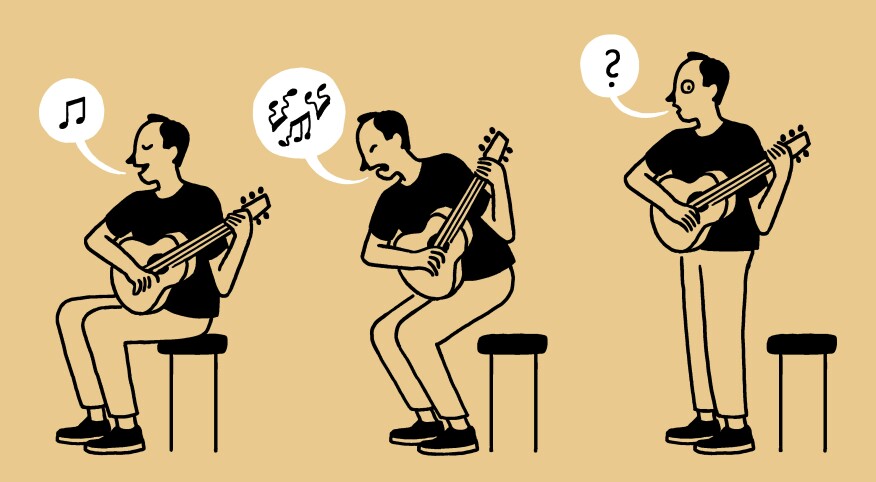Eee-ugh! Eeekgh! H-h-hoy!
Have you uttered any of these unpleasant noises while getting off the couch, bending down to tie your shoe or just doing the barest of body-weight exercises? Have you ever wondered why? We reached out to the professionals for answers.
The getting out of an armchair arrrgh
It’s no secret: Guys grunt. Whether that’s out of pleasure, pain or relief depends on the context — but as you slide into your 50s and beyond, pain is typically the culprit.
“As we age, joints become stiffer,” says Tolga Suvar, a professor of pain medicine at RUSH University Medical Center. “This is just due to natural wear and tear on cartilage, and … the decrease of joint lubricants being produced in the body.”
So you’re basically walking around with your joints smashing together — no lube, totally raw.
And it’s not just because you’re getting older. You’re also getting weaker. But the grunt isn’t a cry for help. It’s a declaration: “I’m not giving up!”
You know how Olympic-level weightlifters make those grunting sounds when lifting weights? Or tennis players grunt when hitting a ball? Studies have shown that it gives their muscles an extra burst of power when they need it. “When people are working at the limits of their abilities, they make these sounds,” says Jack Guralnik, professor of epidemiology at the University of Maryland.
We may not be pro athletes, but sometimes we need the extra strength of a grunt to take us from the couch to the kitchen.
What to do about it
You don’t have to live with weak joint muscles. Strengthen the area around those joints with stabilizing exercises, says Damien A. Joyner, health coach at the University of California, San Diego, and certified personal trainer. “They often call for slower and more controlled movements or holding a position for a certain amount of time.” For example, to keep your legs loose, he recommends slow and controlled calf raises.
The lowering yourself onto a seat oooooofff
Did you ever sit down in your comfy chair and just go euuuugh? Or ahhhh? Or eufff? That’s a sweet hit of relief, baby.
“It’s like air hunger,” says Suvar. “It helps you relax. Usually, people sigh when there’s an accumulation of physical challenges — either stress or stressful activities.”
Indeed, sighing could mean a lot of things. In fact, a 2022 study published in Biological Psychology found that “sighs are associated with dysfunctional breathing, arousal, anxiety, and pain.” That’s right: pain. (We prefer the arousal variety.)
“We’re fighting gravity on a daily basis,” says Suvar. “Aging is associated with gradual loss of muscle mass and strength … so the tasks that were once effortless now become more demanding, and it results in vocal expressions of exertion.”
What to do about it
There’s no fancy secret to keeping your muscles big and your long sighs small. It comes down to functional strength training. “A good foundation to begin with is a pull, push and squats,” says Joyner. Dead lifts, chest presses and even something light like a body-weight squat will help you maintain your muscle as you age.
The leaning over to reach something on the floor bruuugh
Look down. See the lace, untied. Think: This is gonna be a doozy. Bend your hips back to start, bend your knees, and then it comes — the low, slow groan.
“It’s the decreased flexibility of our muscles and tendons,” says Suvar. “They decline as we age, and this can make certain movements like reaching or stretching more difficult and uncomfortable, leading to this audible sound of strain.”
It’s also because your lung capacity is being challenged. “When you bend forward, you’re physiologically changing your lung capacity,” Suvar says. “So you’ve got increased exertion — but also decreased oxygen for those tasks. It takes the wind out of you.”
What to do about it
It may be time to slap on some yoga pants and head to vinyasa class.
Breathing is one of the most important aspects of a good stretch — and thus, to maintaining flexibility. “When stretching, breathing is essential to allow us to get further into the stretch and send a message to the body that it’s OK to relax,” says Joyner.
He recommends starting by stretching the lower back and then pulling your knees to your chest, moving to the hips with a figure four stretch on the floor, then hitting the foot — yes, the foot — with rolling a tennis ball under it for a nice myofascial release.

Christoph Niemann
Follow Article Topics: Health-&-Fitness





